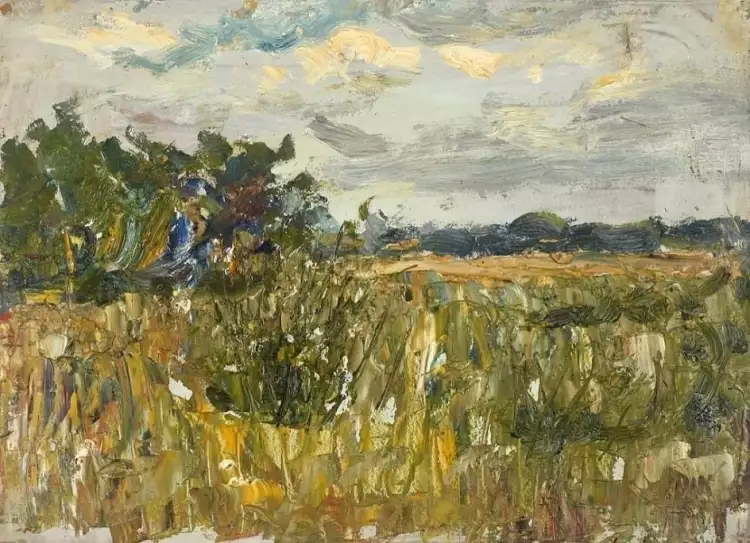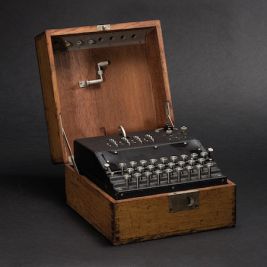
Anatoly Zverev — an unrecognized genius of the Soviet era
Anatoly Timofeevich Zverev (Russian: Анатолий Тимофеевич Зверев; November 3, 1931 – December 9, 1986) was a Soviet avant-garde artist and graphic designer, a legendary figure of Moscow's bohemia in the second half of the 20th century. Anatoly Zverev entered the history of painting as a master who managed to combine the traditions of Russian avant-garde with the latest discoveries of Western art. The artist's biography is an example of the tragic fate of a genius in a totalitarian society, and his work remains largely unknown and underestimated by the general public.
 Anatoly Zverev. Photo of the artist
Anatoly Zverev. Photo of the artist
Anatoly Zverev is known as the founder of Russian Tashism, a form of abstract art in which expression is conveyed through free brushstrokes and patches of color. In his landscapes, still lifes, and portraits, various avant-garde directions merged, transforming into the unique "Zverev style." A characteristic feature of the master's works is the remarkably accurate depiction of movements and images, which he created on simple paper using cheap watercolors and gouache.
 Anatoly Zverev. The painting Self-portrait, 1980s
Anatoly Zverev. The painting Self-portrait, 1980s
Biography of Anatoly Zverev
Anatoly Timofeevich Zverev was born on November 3, 1931, in an old wooden house on the outskirts of Moscow. The boy grew up sickly and weak, and from early childhood, he loved to draw. His parents encouraged his passion and tried to allocate funds from their meager budget to buy colored pencils. Anatoly's school performance was uneven, often receiving low grades, but he was proud that he managed to complete the seven-year school program.
 Anatoly Zverev. The painting Woman with buckets, 1950
Anatoly Zverev. The painting Woman with buckets, 1950
During the war years, Zverev lost his father, and the family was desperately in need of money. After graduating from the vocational art school, the young man found a job as a decorator in Sokolniki Park, where his duties included painting work. Anatoly spent his free time visiting museums, carefully studying the paintings of his idols: Leonardo da Vinci, Francisco Jose de Goya, Diego Velázquez, and Jan van Eyck. Among Russian artists, he particularly admired the Itinerants, and their influence is noticeable in his early works - on small pieces of cardboard, Zverev painted Russian landscapes, adding dynamics and tension to them.
 Anatoly Zverev. The painting Landscape, 1950s
Anatoly Zverev. The painting Landscape, 1950s
His talent helped him get into the Moscow Regional Art School named after 1905, but he didn't stay there for long. Already in the first year, Anatoly was expelled due to frequent disputes with teachers and complaints about his appearance - due to his poor financial situation, the young man dressed too poorly even for the post-war period.
A turning point came in 1954 when the paintings of the artist caught the attention of the famous actor and film institute professor Alexander Rumnev. Thanks to the actor, the capital city became aware of the painter's talent. From the mid-1950s, Zverev's works regularly appeared at bohemian apartment exhibitions, where art connoisseurs would buy them. During this period, the artist was not particularly concerned with "clean" colors - he would mix watercolors and gouache on a regular saucer, and a bowl of water with constantly floating brushes served as his auxiliary tool. The artist worked with incredible speed, often using rags, knives, or shaving brushes, but the result was always impeccable. Looking at his paintings, it was hard to guess that they were created in such an unusual way.
 Anatoly Zverev. The painting Portrait of George Kostaki, 1959
Anatoly Zverev. The painting Portrait of George Kostaki, 1959
Georgy Kostaki, a friend and collector of the artist's works, referred to the late 1950s and early 1960s as the most productive period in Zverev's creative biography. Each of the artist's paintings became a search for new forms in avant-garde art. In 1957, a significant event occurred in the master's life - his works were exhibited at the World Festival of Youth and Students, where they gained recognition from the renowned graphic artist and muralist José David Alfaro Siqueiros.
 Anatoly Zverev. Publication about the artist in Life magazine, 1960
Anatoly Zverev. Publication about the artist in Life magazine, 1960
In 1960, thanks to the publication in Life magazine about the Russian avant-garde genius, Zverev became known worldwide. Five years later, composer and conductor Igor Markevich organized solo exhibitions and sales of the artist's paintings in Copenhagen, Geneva, and Paris, attracting the interest of major American and European museums to Zverev's work. The painter himself never traveled abroad or participated in his own vernissages, but in Moscow, he was torn apart. The master painted a lot on commission and charged a symbolic fee of one hundred rubles for his creations, which allowed him not to worry about money, despite the lack of a regular job at that time.
 Anatoly Zverev. The painting Portrait of Igor Markevich, 1963
Anatoly Zverev. The painting Portrait of Igor Markevich, 1963
By the end of the 1960s, Zverev moved away from experiments and began to pay more attention to secondary details and pure colors, which did not benefit his paintings. At the same time, the artist remained calm in the face of criticism and continued to create. He often created his masterpieces on the floor, laying out tracing paper and using the most unsuitable objects for painting, such as salt, flour, a broom, and even cigarette butts.
 Anatoly Zverev. Drawing of his wife and children. Liusya with her son, 1962
Anatoly Zverev. Drawing of his wife and children. Liusya with her son, 1962
During the artist's lifetime, there were only two major exhibitions in the USSR featuring his participation. One took place in 1975 at VDNKh in the Beekeeping Pavilion, and the second, a solo exhibition, was held in 1984 at the Gorky House of Graphs. The master did not fit within the framework of the concept of "Soviet art," and avant-garde tendencies were unofficially prohibited at that time. The master did not hesitate to publicly criticize the authorities, referring to socialism as a "mess and deception." As a result, the local police officers repeatedly visited his apartment and threatened to send Zverev to compulsory treatment in a psychiatric hospital.
However, even among the Moscow bohemian circles, the artist's behavior was considered excessively extravagant. Despite his decent income, Zverev dressed in second-hand clothing, disliked his home in Sviblovo, and spent most of his time with numerous friends and acquaintances. His visits to friends were always accompanied by drinking, and drunkenness was often referred to as the master's natural state. He moved from one apartment to another, leaving hosts with many of his drawings as a token of gratitude.
 Anatoly Zverev. The painting Portrait of Polina Lobachevskaya, 1978
Anatoly Zverev. The painting Portrait of Polina Lobachevskaya, 1978
His alcohol addiction became the cause of the artist's death. Anatoly Zverev passed away on December 9, 1986, due to a stroke that developed against the backdrop of severe withdrawal syndrome. The entire Moscow beau monde attended the artist's funeral. Every year, friends and admirers of the painter's talent still gather at his grave at the Dolgoprudny Cemetery.
The most famous paintings by Anatoly Zverev
Anatoly Zverev was an artist whom Pablo Picasso considered a brilliant draftsman, and Jean Cocteau referred to as the "Chinese" Honoré Daumier. The master himself considered his fascination with tachism to be the most interesting period of his career, when paintings were created based on emotions and exposed nerves, without any thoughts about what would ultimately appear on the canvas. One of the artist's main principles was the belief that everything should "draw itself, as in nature," and the painter's task was to know how to place the necessary accents. Among Anatoly Zverev's most famous paintings are:
- "The Field" (1955) - the artist particularly loved depicting nature during calm periods before or after a storm. In his abstract paintings, he conveyed the tension he felt from deeply penetrating the world of nature.
- "Portrait of Igor Markevich" (1963) - in his works, the master did not strive to achieve a portrait likeness, but always conveyed the character of the model.
- "Female Portrait" (1967) - this work can be classified as what was commonly called "typical Zverev" in bohemian circles. Amidst the chaos of disorderly lines and brushstrokes, a fragile and touching female image can be discerned.
- "Portrait of Oksana Aseeva" (1969) - Zverev painted hundreds of portraits of his friend Oksana Mikhailovna Sinyakova, the widow of poet Nikolai Aseev. The artist's beloved was nearly twice his age, but their relationship lasted for over 17 years. In his paintings, the elderly woman always appeared young and beautiful.
 Anatoly Zverev. The painting The Field, 1955
Anatoly Zverev. The painting The Field, 1955
 Anatoly Zverev. The painting Female Portrait, 1967
Anatoly Zverev. The painting Female Portrait, 1967
 Anatoly Zverev. The painting Portrait of Oksana Aseeva, 1969
Anatoly Zverev. The painting Portrait of Oksana Aseeva, 1969
Anatoly Zverev left behind a creative legacy of tens of thousands of works. During periods of inspiration, he could create 20-30 paintings in just an hour and a half, which he either gave away or sold for a few pennies. Starting from 1965 and until the artist's death, his works were exhibited over thirty times in the West. Today, Zverev's creations are displayed in the halls of the world's largest museums, including the Tretyakov Gallery, Rutgers University in New Jersey, and The Museum of Modern Art in New York.

 The Resurgence of Vintage Kitchen and Barware: A Collector’s Delight
The Resurgence of Vintage Kitchen and Barware: A Collector’s Delight  Hermann Historica's Anniversary Auction is a triumph
Hermann Historica's Anniversary Auction is a triumph  Performance art - provocative art with profound meaning
Performance art - provocative art with profound meaning  The painting "La Promenade" by Pierre-Auguste Renoir is an example of fleeting happiness
The painting "La Promenade" by Pierre-Auguste Renoir is an example of fleeting happiness  William Turner—the greatest British artist of all time
William Turner—the greatest British artist of all time  Icon - a sacred object in Christian culture: types, distinctive features, history
Icon - a sacred object in Christian culture: types, distinctive features, history  Art: its essence, types, genres, and history
Art: its essence, types, genres, and history  Digital and Interactive Art: Redefining User Experience in Contemporary Art
Digital and Interactive Art: Redefining User Experience in Contemporary Art  The Return of Nature: Embracing Nature Renewal Art in 2024
The Return of Nature: Embracing Nature Renewal Art in 2024  Michelangelo - the greatest sculptor in the world: biography and works of the Italian artis
Michelangelo - the greatest sculptor in the world: biography and works of the Italian artis